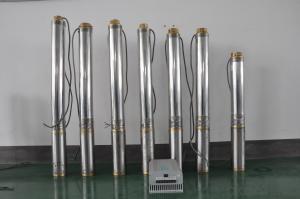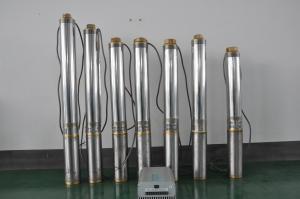DC Water Pump
- Loading Port:
- China Main Port
- Payment Terms:
- TT OR LC
- Min Order Qty:
- -
- Supply Capability:
- -
OKorder Service Pledge
OKorder Financial Service
You Might Also Like
Item Description :
This superb new addition to our solar fountain range comes with a 10w solar panel,and a powerful fountain pump that is capable of producing fountains of up to 2m in height. As well as being easy to set up and use.Instruction manual is supplied for assembly and maintenance.
Solar Fountain Key Features :
Powered by direct sunlight
No high voltage electric mains required
Safe for children
Max. height of fountain: 2M
Max. flow capacity: 800 L/H(176 GAL)
10W Polycrystalline solar panel included
18V DC brushless pump
Solar Pump Features :
Can produce fountains up to : 2M (tube height) 1.4M (fountain height)
Comes with multiple nozzle accessories
Cable Length : 5M
Solar Panel Features :
10W peak power.
Polycrystalline highly efficient solar panel
Comes mounted in aluminium frame
Comes with ground stake and rotating knob so you can angle your panel toward the sun
What You Will Get :
10W solar panel
Solar pump
Ground Sake
Nozzle accessories
Precautions :
DO NOT alter or change the product itself or its components
Operate pump in freshwater only, never above 50 degrees celsius
Keep away from flammable liquids
Do not connect to any other power supply other than the included
- Q:Can a solar pump be used for fire fighting purposes?
- Yes, a solar pump can be used for fire fighting purposes. Solar pumps are capable of providing a reliable and continuous water supply, making them a suitable option for firefighting operations in areas where there is ample sunlight. The use of solar pumps can help reduce reliance on traditional power sources and provide a more sustainable and cost-effective solution for firefighting needs.
- Q:Can a solar pump be used for snowmaking in ski resorts?
- Yes, a solar pump can be used for snowmaking in ski resorts. Solar pumps are an environmentally friendly alternative to traditional pumps that are powered by electricity or diesel engines. They utilize solar energy to power the pump, which reduces carbon emissions and operating costs. Since ski resorts typically have ample sunlight, solar pumps can effectively generate the required water pressure and flow rate needed for snowmaking. Additionally, solar pumps can be easily integrated into existing snowmaking systems, making it a viable option for ski resorts looking to reduce their environmental impact.
- Q:What is the payback period for investing in a solar pump?
- The payback period for investing in a solar pump can differ depending on various factors, such as the initial pump cost, installation expenses, energy savings, and any applicable incentives or subsidies. Typically, the payback period for a solar pump ranges from 3 to 7 years. Throughout this timeframe, the cost savings from utilizing solar energy instead of traditional energy sources, like electricity or diesel, will gradually compensate for the initial investment. Once the system is installed, solar energy is essentially free, resulting in significantly reduced operating costs and long-term financial advantages. Estimating the payback period requires considering the local climate and water requirements for your specific application. In areas with abundant sunlight and high water demands, the payback period may be shorter due to increased energy savings. Conversely, regions with less sunlight or lower water requirements may experience a slightly longer payback period. Additionally, government incentives, tax credits, or grants for renewable energy systems can greatly impact the payback period. These financial incentives can reduce the initial investment and expedite the payback period, making solar pumps even more economically feasible. To accurately determine the payback period for a solar pump, it is advisable to consult solar energy experts or suppliers. They can assess your specific needs, estimate costs, and provide a more precise calculation based on your location and circumstances.
- Q:What is the maximum temperature a solar pump can handle?
- The maximum temperature that a solar pump can withstand may differ based on the specific model and manufacturer. Nevertheless, most solar pumps are generally built to endure temperatures ranging from 50-60 degrees Celsius (122-140 degrees Fahrenheit). To determine the exact maximum temperature rating for a particular solar pump model, it is crucial to consult the manufacturer's product specifications. Moreover, it is recommended to install the pump in a location that reduces exposure to extreme temperatures and guarantees sufficient ventilation for optimal performance and longevity.
- Q:How does a solar pump handle power outages or blackouts?
- A solar pump does not rely on grid power, so it remains unaffected by power outages or blackouts. It operates independently using solar energy, making it a reliable solution even during times when there is no electricity supply.
- Q:How much maintenance is required for a solar pump?
- Solar pumps typically require very little maintenance. They are designed to be low maintenance and reliable, with minimal moving parts. Regular maintenance generally involves cleaning the solar panels to ensure maximum efficiency and checking the pump for any debris or blockages. Overall, the maintenance required for a solar pump is minimal compared to traditional pumps powered by electricity or fuel.
- Q:Can a solar pump be used in areas with limited access to water purification systems?
- Yes, a solar pump can be used in areas with limited access to water purification systems. Solar pumps are designed to draw water from various sources such as wells, rivers, or ponds. While the water may not be purified through traditional methods, such pumps can provide a consistent supply of water for various purposes like irrigation or household use. However, it is important to note that additional water treatment methods may be required to ensure the water is safe and suitable for drinking or other sensitive applications.
- Q:Can a solar pump be used for emergency water supply?
- Yes, a solar pump can be used for emergency water supply. Solar pumps use solar energy to power the pumping mechanism, which means they do not rely on electricity or fuel, making them ideal for emergency situations where power may be limited or unavailable. They can be used to extract water from wells, rivers, or any other water source, providing a reliable and sustainable solution for emergency water supply needs.
- Q:How long does it take to install a solar pump?
- The installation time for a solar pump can vary depending on various factors such as the size and complexity of the system, site conditions, and the expertise of the installation team. However, on average, a typical solar pump installation can be completed within a few days to a couple of weeks. It is recommended to consult with a professional installer who can assess your specific requirements and provide a more accurate estimate.
- Q:Are there any limitations to the type of water a solar pump can handle?
- There are certain restrictions when it comes to the type of water that a solar pump can handle. One constraint is the presence of debris or sediment in the water. Generally, solar pumps are engineered to manage clean water, and if the water contains a large amount of debris, it can lead to the pump becoming clogged or damaging its components. Another limitation is the level of salinity in the water. Although solar pumps can handle water with some salinity, there is a threshold beyond which the pump's efficiency may decrease or it may suffer damage. The specific tolerance for salinity can differ depending on the type and model of the solar pump. Furthermore, the temperature of the water can also impact the performance of a solar pump. Extreme temperatures, whether excessively hot or cold, can affect the pump's efficiency and lifespan. Solar pumps are typically designed to endure a specific range of temperatures, and operating outside of this range can cause problems. Lastly, the depth of the water source can also be a restriction. Solar pumps are generally suitable for shallow water sources, such as wells or ponds. If the water source is too deep, the pump may not be capable of efficiently lifting the water to the desired height. In conclusion, it is crucial to consider these limitations and ensure that the type of water and its conditions align with the specifications of the solar pump being used. Consulting the manufacturer's guidelines and recommendations can provide more specific information regarding the limitations of a particular solar pump model.
1. Manufacturer Overview |
|
|---|---|
| Location | |
| Year Established | |
| Annual Output Value | |
| Main Markets | |
| Company Certifications | |
2. Manufacturer Certificates |
|
|---|---|
| a) Certification Name | |
| Range | |
| Reference | |
| Validity Period | |
3. Manufacturer Capability |
|
|---|---|
| a)Trade Capacity | |
| Nearest Port | |
| Export Percentage | |
| No.of Employees in Trade Department | |
| Language Spoken: | |
| b)Factory Information | |
| Factory Size: | |
| No. of Production Lines | |
| Contract Manufacturing | |
| Product Price Range | |
Send your message to us
DC Water Pump
- Loading Port:
- China Main Port
- Payment Terms:
- TT OR LC
- Min Order Qty:
- -
- Supply Capability:
- -
OKorder Service Pledge
OKorder Financial Service
Similar products
New products
Hot products
Related keywords



























